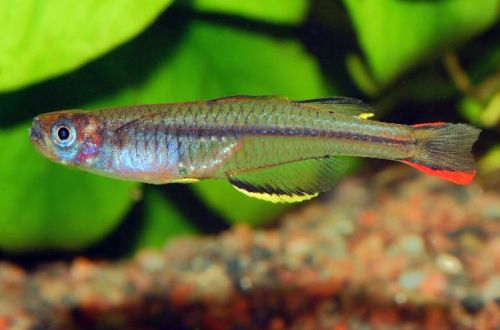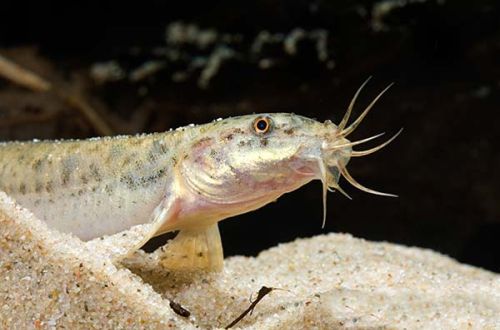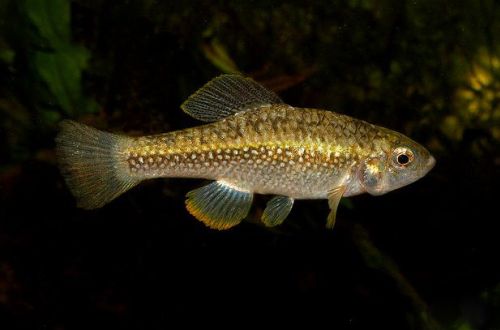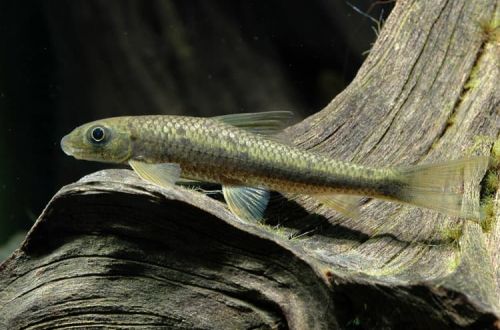
Blue-eyed New Guinea
The New Guinean blue-eye, scientific name Pseudomugil novaeguineae, belongs to the Pseudomugilidae family. A bright representative of the iris fish, characterized by a variegated color. Mobile peace-loving species, but with difficult intraspecific relationships. Maintenance is associated with some difficulties in ensuring high water quality. Not recommended for beginner aquarists.

Contents
Habitat
As the name implies, the fish comes from the island of New Guinea and the nearby Indonesian Aru Islands. Inhabits shallow slow-flowing streams and rivers flowing through flat areas among dense tropical forests.
Brief information:
- The volume of the aquarium – from 60 liters.
- Temperature – 22-28°C
- Value pH — 5.5–6.5
- Water hardness – 10–18 dGH
- Substrate type – any
- Lighting – subdued
- Brackish water – no
- Water movement – moderate
- The size of the fish is about 4 cm.
- Food – any food
- Temperament – peaceful
- Keeping in a group of 3-4 individuals with a predominance of females
Description
Adults reach a length of about 4 cm. The fish have a translucent body with a turquoise sheen on the abdomen and head. The eyes have a subtle gold rim around the pupil and a bluish iris. Males are more brightly colored. The edges of the tail are red, while the ventral and anal fins are yellow. The edges of the forked dorsal fin are also marked in black or yellow.
Food
Prefer small live or frozen food. Can be accustomed to a dry product in the form of flakes, granules containing a large amount of protein. Only high-quality feed will ensure the bright color of this fish.
Maintenance and care, arrangement of the aquarium
The optimal size of the aquarium for a flock of 4-6 fish starts from 60 liters. The width of the reservoir is more important than its depth, since the New Guinea blueeye lives mainly near the surface. The design focuses on the upper water layer, where it is necessary to combine open areas for swimming with places for shelters in the form of clusters of floating plants.
The main difficulty in the content is associated with the need to maintain the pH of the water in a rather narrow range of 5.5–6.5, as well as to prevent the accumulation of organic waste that can increase the nitrate content (a product of the nitrogen cycle). A productive filtration system and regular maintenance of the aquarium (replacing part of the water with fresh water and cleaning the soil) are a must.
Behavior and Compatibility
Peaceful active fish, get along well with other species of comparable size. However, males during the breeding season show excessive attention towards females, forcing them to hide until they are ready to spawn. A similar feature of behavior involves the acquisition of only one male in a company with several females in a small aquarium. In other cases, it is also recommended that the number of females be larger.
Breeding / breeding
At the time of preparation of the article, little reliable information about the reproduction of the Blue-eyed New Guinea was published.
Breeding success depends on a combination of several factors: a balanced diet and high water quality. The closer the conditions of the aquarium correspond to the natural habitat, the higher the chances of spawning. Caviar is laid among dense thickets of small-leaved plants, mosses or ferns. The eggs have a bright red color.
Fish diseases
In a favorable environment, cases of the disease are rare. When the first symptoms of the disease appear (lethargy, deformation of the body, the appearance of spots, etc.), it is first necessary to check the quality of the water. Probably, bringing all indicators of the habitat back to normal will allow the body of the fish to cope with the disease on its own. Otherwise, medical treatment will be required. Read more in the section “Diseases of aquarium fish”.





